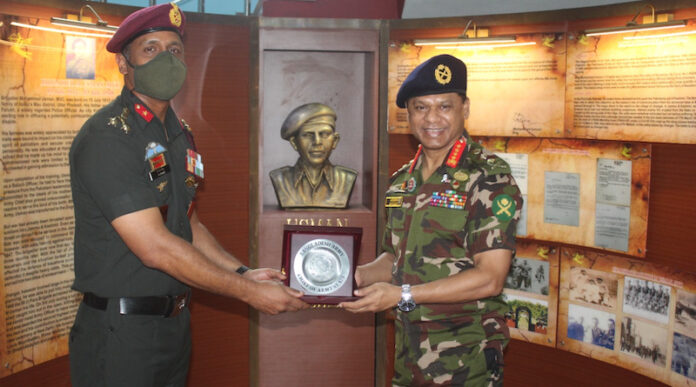Defence cooperation between India and Bangladesh has made significant progress in the last few years. It is depicted in the exchange of visits between the leaders of the two countries, as well as the conduct of training programmes, joint exercises, and humanitarian assistance and disaster relief (HADR). Cooperation between the two countries is extensive in all areas, so defence and security are inevitable.
Bangladesh is also showing interest in importing military hardware from India. With India opening a $500 million credit line for defence procurement, Bangladesh aims to buy military equipment such as specialized vehicles, Tejas light combat aircraft and Dhruv light helicopters. Bangladesh also seeks Indian assistance in maintaining Russian-origin equipment like Mi-17-IV helicopters, An-32 transport aircraft and MiG-29 fighters. While Bangladesh already buys protective gear like bulletproof jackets and helmets.
Bangladesh is India’s closest neighbour and a strong component of the “Indian Neighbourhood Policy”. In 2017, Bangladesh signed two defense agreements, for joint exercises and training, and for specialist training and logistical support from India for Bangladesh. Counter-terrorism is aanother area for cooperation. It is essential to suppress the nexus of insurgents and drug lords in India’s Northeast. Bangladesh has pledged to ensure that “no neighbouring country can use Bangladeshi soil for terrorist activities).
Bangladesh Army Chief Gen S.M. Shafiuddin Ahmed, recently on a three-day visit to India, met Indian counterpart Gen Manoj Pandey and discussed overall bilateral cooperation, and especially counter-terrorism. General Shafiuddin met Gen Pandey in New Delhi on Thursday. According to the Indian Defence Ministry statement, he was given a guard of honor at the South Block lawn. He also met the other service chiefs, and the Defence and Foreign Secretaries.
The Indian Department of Defense Production and the Army Design Bureau also briefed General Shafiuddin about the Indian domestic defence production ecosystem. An ‘Implementation Arrangement’ was also signed between India’s Centre for United Nations Peacekeeping and the Bangladesh Institute of Peace Support Operations Training for cooperation in UN peacekeeping operations and training between the two armies.
General Shafiuddin laid a wreath at the Indian Air Force War Memorial. More active participation of India and Bangladesh in the UN Peacekeeping Force was also discussed. He was the reviewing officer of the passing- out parade at the Officers Training Academy in Chennai.
India and Bangladesh share a historical legacy of cooperation and support during the 1971 Liberation War.
The army chief’s visit, most importantly, comes at a time when the Bangladesh government has recently formally set out the ‘Indo-Pacific Outlook’, and Myanmar and Bangladesh are trying to resolve the Rohingya crisis with Chinese mediation. The visit is apparently part of the “outstanding” bilateral defence relationship between Bangladesh and India.
Bangladesh can gain confidence from the Indian government as India is an active member of the Indo-Pacific Alliance. Bangladesh, on the other hand, can counter China’s predicament intelligently as it aims to engage structurally rather than militarily. DefenCe and security are important components of Indo-Bangladesh bilateral relations and their armed forces coordinate at various levels. India can assist Bangladesh in achieving its visionary military plan, “Forces Goal 2030”. It can help strengthen bilateral relations and reflect improved bilateral understanding..
India’s $500-million credit for procurement of defence equipment, particularly communications and coast guard patrol boats, came into focus. While the strategic objectives are obvious, there are other considerations. Bangladeshi companies can tap into the supply chain network of major equipment manufacturers. Bangladesh can be a big market for Indian defence products.
In terms of defence, relations between India and Bangladesh go back to 1971, when the Indian Army fought alongside Bangladeshi freedom fighters. Over time, the defence ties were eroded. But since this government came to power, there has been significant progress in defence cooperation.
Bangladesh is an important ally of India in South Asia. The two work together on issues such as climate change, counter-terrorism and regional security. The visit could strengthen bilateral defence ties. Defence cooperation can strengthen bilateral relations.
Bangladesh and India must work together as reliable partners to resolve certain partnership issues. India and Bangladesh have strengthened their defense ties through this visit.
General Shafiuddin and General Pandey spoke via video chat early last year in a bid to improve bilateral defence cooperation. They are also believed to have discussed how the geopolitical landscape is changing and how it will affect regional security.
For a long time, Bangladesh was reluctant to address India’s security concerns, primary among which was the presence of many insurgent groups in its northeastern region who enjoyed safe haven in Bangladesh and operated across the border. India also believed that militant outfits with roots in or links to Pakistan were using Bangladesh as a transit point. India has repeatedly urged Bangladesh to take action against such groups, only for it to deny their existence.
When Sheikh Hasina became PM in 2009, she vowed to crack down on groups active in Bangladesh that were against India’s interests. Bangladesh has helped arrest top rebel leaders, including Arvind Rajkhwa, chairman of the United Liberation Front of Assam, and Ranjan Daimari of the National Democratic Front of Bodoland. This proved a turning point for bilateral relations.
Currently, India and Bangladesh are cooperating in various economic, social, scientific and technological fields. In 2014, the two countries settled their maritime boundary dispute, in 2015 the land one. Defecse ties have grown manifold since Bangladesh Army Chief Gen Moin Ahmed’s visit to India in 2008. The heads of their armed forces now visit each other regularly; The presidents of both countries, who are the commanders-in-chief of their armed forces, also exchanged visits, Pranab Mukherjee of India in March 2013, his Bangladeshi counterpart Abdul Hamid in December 2014. Ongoing discussions between the top leadership of the armed forces have helped to remove previous misconceptions on both sides.
India must take advantage of its cultural ties with Bangladesh and work to invite more officers and personnel for training. Although currently, there are several travel exchanges among the staff, more steps can be taken to strengthen engagemen. Industry-to-industry discussions should be encouraged to facilitate trade relations in defence.
The views of the defence forces are considered a defining factor in Indo-Bangladesh relations. After all, Indian and Bangladeshi armies fought the liberation war jointly. The increase in defence cooperation with India indicates the Bangladesh Army’s interest in developing defence ties with India. Bangladeshi security analysts observed that the importance of good relations with India is now widely understood. This is not to say that years of mistrust and apprehension can be completely banished, especially within the military. Although India was sceptical about signing an MoU instead of a treaty, analysts say a comprehensive defence agreement may not gain acceptance easily but the MoU will create an opportunity to expand cooperation.
The MOUs are protected by confidentiality clauses,, making a detailed analysis difficult. They keep in mind the past, present and future. Moreover, the MoU on ‘Future Cooperation Framework’ implies that these discussions are being undertaken with a long-term perspective.
Counter-terrorism cooperation is an important aspect of the relationship, as both countries have been victims of terrorism and face increasing security threats. To effectively counter thesm, there is a need for greater coordination between the armed forces, inter-agency coordination and cooperation, joint training and exercises, greater interaction and understanding.
Peace and tranquility in the Bay of Bengal is an important aspect and both countries have important roles. After demarcating maritime borders with India and Myanmar, Bangladesh acquires a large swath of land in the Gulf and has a major stake in maintaining law and order in the region.
No major incidents of piracy have been recorded in the Gulf region (as in Somalia), except for a few cases of petty robbery. However, the region is vulnerable to such organized crime as human trafficking, and arms and drug smuggling. Coordination between navies and coast guards will help address such challenges. In this regard, the cooperation agreement between the coast guards of the two countries has taken a step forward.
Another significant outcome of such cooperation would be the security of maritime trade. The Gulf is a major trade route for coastal countries, especially for Bangladesh, as it provides exclusive access to the sea and most of its trade is through maritime routes. Search and rescue operations would also stand to benefit from such cooperation, since the Gulf is vulnerable to natural disasters.:
These MoUs will strengthen cooperation between the two countries in the field of Humanitarian Assistance and Disaster Relief (HADR). Frequent cyclones in the Gulf are a constant challenge, demanding advanced HADR skills. Interaction provides opportunities to learn from each other’s experiences while ensuring smooth and effective coordination in times of need.
Both India and Bangladesh are working to ensure prosperity. They are among the world’s fastest growing economies. India ranks among the top 10 economies globally, while Bangladesh is an emerging economy. Bangladesh has maintained a growth rate above six percent for over a decade. Both countries strive to improve their economies, and peaceful and friendly relations with neighbours are crucial.
India’s $500-million credit for procurement of defence equipment, particularly communications and coast guard patrol boats, came into focus. While the strategic objectives are obvious, there are other considerations. Bangladeshi companies can tap into the supply chain network of major equipment manufacturers. Bangladesh can be a big market for Indian defence products. Due to the ‘Make in India’ initiative, many multinational companies are setting up units in India and can become a major supplier of arms. It would be convenient for Bangladesh to procure arms from its immediate neighbours. This allows it to negotiate on issues such as technology transfer. Ultimately, this could help Bangladesh evolve from a buyer to a producer of high-end technology products.
Any discussion of India-Bangladesh defence cooperation is incomplete without considering the Chinese factor. China is Bangladesh’s strategic partner and its largest arms supplier. Indian security analysts, however, have been eyeing that relationship.
Security observers in Bangladesh say the issue is more economic than strategic. The government has adopted an Armed Forces Vision 2030. Bangladesh is also buying large quantities of weapons. It is working to transform its navy into a three-dimensional force. Therefore, submarines are considered a necessity. Defense analysts, however, take a different view as they believe that Bangladesh faces little threat from other countries.























